Dr. Salvatore Ruffino, the Triumph distributor for Italy, felt there was room in the growing postwar automotive market for a mildly upscale sports/GT car. Through his friend, Mr. Zambrini, the director of Autobianchi, Dr. Ruffino met with Zagato to discuss designs for a two seat coupé. The subsequent drawings did not meet his expectations and he decided to try a different stylist. Giovanni Michelotti produced several drawings and a prototype was commissioned. Initially, the cars were to be built by a firm named Romanazzi but Dr. Ruffino's deadline for production could not be accommodated. With Michelotti's close connections to Vignale, an arrangement was made to produce the cars there but on an assembly line owned by Dr. Ruffino.
At this point, Standard-Triumph was deeply involved in the Triumph Italia. Both Harry Webster and Martin Tustin were at the unveiling at the 1959 Turin Auto Salon. Both the Second Prototype and the first show car (stamped Italia #1) were sent to the factory in Coventry for review. #1 was tested at the M.I.R.A. test track where it was recored as the second fastest Triumph ever. Even though with only 1200 miles on the clock, it was barely broken in. Something the engineers noted.
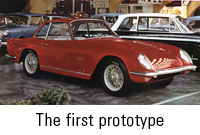
As the Italian importer of Standard-Triumph, Dr. Ruffino decided upon the TR3A chassis to use as the basis of his new sport coupé. Negotiations were initiated with Mr. C. L. P. Edmonds, the Triumph representative in Italy, to require every Triumph dealer to purchase one Italia for a total of 720 cars. With this in mind, Dr. Ruffino planned to produce 1000 cars, 500 in 1960 and 500 in 1961.
The original prototype, nicknamed by modern day Italia owners as the "slope-nose," was not called an "Italia" in Michelotti's drawing but as the "Special VM" Triumph TR3 coupé 2 posti. However, the name was visible on the prototype itself and on a plaque in front of the car at the 1958 Turin Auto Salon. This design was reportedly modified because of stability issues at high speed and a tendency to overheat. The second prototype is much more easily identified as an "Italia." There are many small styling details that would be changed for production. Both the second prototype and the first "production" Italia (marked as body number 1) spent time at the Standard-Triumph styling studio. No.1 was tested by Triumph at the' M.I.R.A. test track and recorded the fastest time for a Triumph up to that point excluding one other car (we believe that car might have been one of the Sabrina-engined Le Mans TR's). It's performance was noted as surprising, since the car had barely been broken in, covering only about 1200 miles. According to Dr. Ruffino's son, Dario, the original prototype was later modified to a standard production model. We are still looking for the commission number for the first prototype. It is possible that an "X" chassis was used. These were used for Standard-Triumph prototypes and test vehicles. If that is the case, the prototype may have been returned to Triumph or dismantled.
"Some cars have a particularly pleasing stance when observed from another vehicle; the Italia is one of them"
—Autocar 1960
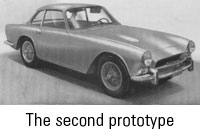
All the major magazines reported on the Italia with glowing reviews and hopes that it was the shape of things to come from Triumph. Unfortunately, business at this time started to become difficult for Standard-Triumph. The imminent takeover by Leyland, and the introduction of the TR4, meant the Italia was to become a footnote in Triumph history. Dr. Ruffino had already begun to produce the cars and decided to continue on his own. The first 13 chassis were shipped directly to Vignale and completely assembled by them. These 13 cars were used for promotion and testing. Their badging and interior trim is different from the later "production" cars. They are easy to spot by the lack of a marker light on the front wings. Dr. Ruffino took over final assembly of the cars for the remainder of the production run with Vignale producing the bare body on chassis. The Italia was no longer called the "Triumph Italia" but now became the Italia 2000. The Triumph name remained on the rear wings of the car with the badge "T. M. Triumph." It is now thought that the "T. M." stands for “telaio e motore”, Italian for “chassis and motor.” We owe a debt of gratitude to Italia owner, Dr. Albrecht Heinrici for making this discovery.
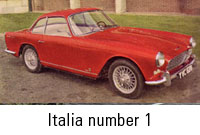
Triumph did recognize the Italia and gave it it's very own production specification. Chassis numbers are typical TR3 starting with TS or TSF (for the last thirty) and ending in "CO" or "COO", for chassis-only or chassis-only with overdrive. Other than the very easliest cars, perhaps just the first thirteen, all Italias were to have received heavy duty shock absorbers, 7 leaf rear springs and a front anti-sway bar. Italia engines were also to have an "I" at the end of the engine number. Triumph's delivery of some chassis that did not meet the requirements spelled out in the "Italia Specifications" led Dr. Ruffino to start legal action. As such, some cars may not have come equipped with the anti-sway bar and 7-leaf springs. Later production cars and all the TSF cars have uprated 6-leaf rear springs as used on the TR4.
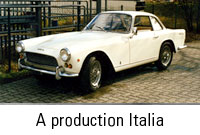
Dr. Ruffino had his distribution system in place in Italy, France and Germany but needed access to America. Help came in the form of Stutz Plaisted. A Volvo dealer in Massachusetts, Mr. Plaisted became the U.S. importer of the Italia (except for the last 30 cars). Stutz, as sole importer, made arrangements with other dealers in the U.S. to handle the cars.
U.S. purchasers were required to sign a waiver acknowledging that no body parts were available, European owners could return their cars to Dr. Ruffino for repair.
"When one of these was seen in Monte Carlo back at Grand Prix time it caused a lot of whistles . . ."
—Motor Sport 1960
Only six cars were originally built as right-hand drive. These chassis were shipped to Italy in one batch. One of them is the only Italia where both the interior and exterior colors, options and the name of the original dealership were listed along with the shipping invoice in the museum archives. No.1 was eventually converted to right-hand drive. Judging by the way #1's right-hand drive dashboard was constructed, this probably occurred after Standard-Triumph sold the car.
Recent information based on details from Mike Cook of Standard-Triumph and Felix Maher, owner of #203 and #327, gives new insight into those last 29 TSF cars. The chassis for Felix's #327 was shipped to Italy on September 10th, 1962 and dispatched by Standard-Triumph to Baltimore on June 30th, 1964! The car sat outside in Italy for a year and a half. Most likely along with the other TSF cars.
Mike remembers a few of the Italias in the parking garage at Triumph's Manhattan offices. They had just arrived and needed repainting and all the interiors were mildewed. Mike wasn't impressed partially because they had already been selling the TR4 here for 3 years. The Italia, with non-synchro first gear and worm and peg steering, would have seemed old news. Mike used a royal blue one, that had faded to a flat purple, for a weekend. A couple of the Triumph executives also used them as company cars. According to Mike, when Ruffino gave up the distributorship for Italy, his contract with Triumph required them to purchase any remaining parts and stock. So, Triumph became the (somewhat reluctant) owner of those TSF-based Italias. These were shipped by Triumph to Baltimore on the basis that they would probably sell in America. The cars, being left-hand drive, would not have been very desirable in the U.K.
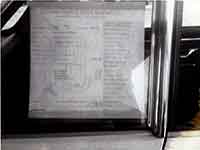
An early attempt at discovering the Italia's history placed about 6 TSF Italias at John Copeland's dealership in Norfolk, Virginia in the mid-sixties. Based on a period photo supplied by former owner, Bill Clark, at least one ended up at Paquette Motors in Orlando, Florida. Bill sold the car to Robert Slayden and included this very faint Polaroid of the dealer's window sticker. What's surprising is the extra $35 charge for a back seat as all Italias came with one. A total cost of $5,130 in 1965. Italia #315 was first titled in Springfield, Maryland in September 1965 and #311 in Virginia, also in 1965.
The Italia never reached the proposed 1000 cars with only around 330 produced (including the two prototypes). After a long search through the British Motor Industry Heritage Trust archives, 325 chassis have been identified as being shipped to Italy. Recent information raised the probability of a further five yet to be found on the next visit to the archives. Today, many of the cars originally exported to the U.S. have returned to Europe. Approximately 125 Italias have been found to date. We are certain of two cars on our list having been parted out/scrapped and one written off in a crash. A photo in a period Italian article on car safety, shows another destroyed in a crash (See the "Surviving Italias" page for a list). Dr. Ruffino's son, Dario, who had helped his father with the Italia project, kindly offered much of the early history on this page in an interview with Jörg von Appen.
If you found this site helpful, please consider making helping offset the costs of maintenance. Donations will also help purchase the rights to more of these rare photos. Join the Italia Club!